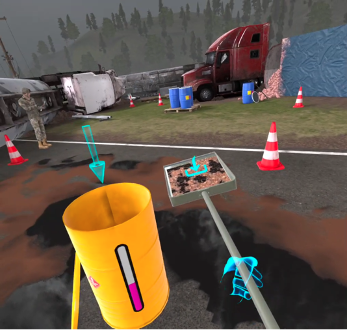Big Data and XR for Emergency Response Management

15 February 2024
Felix Höfer, Head of Coding at Northdocks
Tim Waldron, Project Manager at Northdocks
In today's world, where natural disasters seem to be occurring with increasing frequency and intensity, the importance of effective emergency and disaster management cannot be overstated. It's a collective effort that requires international collaboration between countries, organisations, and individuals to tackle these challenges head-on.
This new approach to disaster management creates complex scenarios, where language barriers, cultural differences, and a multitude of varying factors can greatly impact the effectiveness of cooperative measures. As such, a data-driven approach to disaster management and emergency response actions is crucial. While it may be possible to tackle minor emergencies with local teams, larger situations require a broad combination of strategic and administrative roles, as well as dedicated and well-trained ground crews, both of whom have to be able to work together seamlessly. Any disruption in these processes can cause major damage and human suffering. The Rhine floods in Germany in 2021, which saw over 160 casualties, demonstrate the terrible consequences of unclear communication and a breakdown in emergency management procedures.
The question arises: How can we prevent acute emergencies from turning into uncontrollable catastrophes?
The core principles of effective management are centerd around planning, organising, leading, and controlling situations. This requires a clear understanding of the ground situation, clear communication paths, and functioning structures that can quickly and dynamically be utilised and adapted to varying situations. The data-driven approach of TEMA aims to create an international platform that can offer a wide range of tools for understanding and planning emergency procedures. The culmination of the data-driven approach is a Digital Twin, that can offer a three-dimensional map of affected areas and environmental issues. This set of TEMA-Tools will provide administrative and strategic roles with a new approach to data analysis, as it gives an approximation of real ground-level situations and offers a valuable platform for communication, planning, and execution of actions.
For ground crews, an important feature is extensive training to allow quick and coordinated responses to emergencies and constantly changing ground situations - even if there is a temporary breakdown in communications between individual teams and strategic planning groups. For these trainings, there are a variety of possible solutions, ranging from local role-playing trainings to large-scale disaster simulations. XR offers an innovative and powerful approach to this sort of training and can allow for very flexible and cost-effective solutions. One of the main benefits of XR technology is the possibility to work outside of spatial limitations. This means that training within XR simulations can happen within a small physical area of about one square foot. Within this small physical space, a virtual environment can be projected that can be up to several square miles in size. In essence, this allows trainees to train in complex scenarios within the confines of a normal office. As for the trainings themselves, these can encompass a wide range of custom solutions. For example, there is currently a major project concerning an American branch of disaster management that is intensifying its implementation of XR simulations for emergency training. These trainings range from simple recruitment and information tools to complex interactive simulations of real-life emergency scenarios. The range of these trainings extends from situational awareness training in wildfire situations to helicopter rescue simulations and infrastructure management services, such as road clearances, emergency bridge building, or decontamination tasks.
To combine the specifics of ground-crew training and big data-driven planning, there are currently various ongoing international projects that aim to use XR as a tool to train the communication between management and ground-crew roles. These projects aim to train interdisciplinary communication between different teams and also international collaborations that go over borders, and are a crucial element in creating a seamless communication path between the various individual task forces within an emergency situation..
In conclusion, Big Data and XR offer significant benefits to future emergency responses and disaster management, and enhance the possibilities of managing and solving complex emergency situations. We are only just beginning to utilise these technologies, but the potential is significant and will have a major impact on response times and coordinated efforts to tackle the challenges of the future.
Bibliography
[1]Virtual Reality for Emergency Situations Training. Available at: https://www.sfpe.org/publications/periodicals/sfpeeuropedigital/sfpeeurope12/issue12feature6
[2]Virtual Reality for Firefighter Training. Available at: https://www.firefightervr.de/?locale=en
[3]Virtual Reality for Police Training. Available at: https://shotpros.eu/
[4]Virtual Reality for Workplace Emergency Training. Available at: https://pixovr.com/vr-training-categories/workplace-emergency-training/
[5]Project TEMA for Disaster Management. Available at: https://tema-project.eu/project-description

